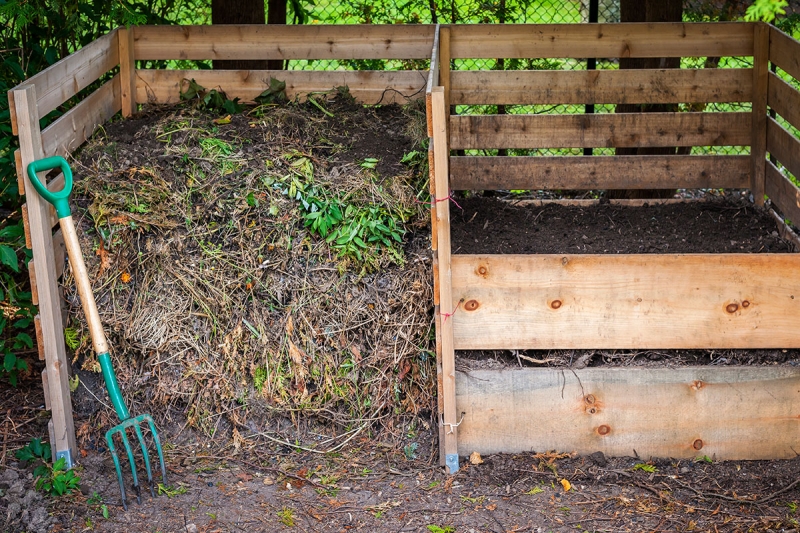Why Compost?
"Composting is a giant step toward recycling wastes, conserving precious energy reserves, and regaining control of our food supplies.” ~ Rodale Book of Composting
Creating a compost pile is one of the best investments you can make in your garden. Composting is the keystone to a successful, sustainable organic garden. Rather than sending your garden wastes to the landfill and spending upwards of $50 a year on fertilizers, your compost pile allows you to invest your precious plant materials in your own garden and to produce soil you’ve only dreamed of.
Compost will:
- Add organic matter naturally
- Prevent plant and soil diseases
- Correct sandy or clay soil structure
- Make a great mulch or top dressing
- Provide a variety of nutrients when plants need them
- Aerate soil
- Improve Drainage
- Prevent erosion
- Neutralize toxins
- Recycle garden and kitchen wastes
Building a Pile
As our favorite bumper sticker says, “Compost Happens.” If you put organic material in a pile, it will eventually break down to composted matter. However, there are many ways to control this magical process through the size and shape of the pile and the various materials added to it. You can have a “cold pile,” to which you add materials, such as kitchen scraps, on an ongoing basis. This pile will compost rather slowly (1-2 years).
The faster route requires the creation of a “hot pile”, which should reach temperatures of 140° F. This pile is created with all the materials it will need, so by adding water and turning it regularly, you can help this pile finish composting within 6-8 months. All healthy compost piles require the following:
Browns - "Browns" are dry materials such as leaves or straw that provide carbon. Browns should compose roughly one-half of your pile (by volume).
Greens - "Greens" are green materials such as grass or freshly pulled plants from your garden that provide nitrogen. Greens should compose roughly one-half of your pile (by volume).
Water - The organisms in your compost pile need a moist environment to live in, especially in our desert climate. The inside of your pile should have the consistency of a wrung-out sponge.
Air - Turning your pile adds air to the mix. Organisms in the pile need a source of oxygen if they are going to thrive.
Build Your Pile!
Loosen the soil with a digging fork or shovel where you intend to build pile/have bin.
As a bottom layer add thick materials such as sunflower stalks or sticks. This improves aeration and creates an open invitation for decomposers to start working!
Chop up browns and greens to 1”-2” pieces for faster decomposition.
Mix a bit of greens and browns with little bit of water and add to bin, keep adding until pile is at least 3ft x 3ft x3ft.
When finished, your initial pile should be as moist as a wrung out sponge.
Turn every three days to keep a hot pile and add oxygen (may need to add water)
Watch as compost happens!
Your pile is finished when it won’t heat up, resembles soil & smells good!
Let the compost cure for 1-6 months before applying to your garden.
Choices
There are a few different ways to shape your composting process. A gardener’s choice of composting method should be convenient and reflect personal preference and aesthetics. Your home pile can be contained in a bin made of wood or plastic. Some people even use wire cages. Home gardeners may opt for composting underground through sheet-composting, where plant material is buried under soil for a few months.
Tips
As mentioned above, a moist pile is crucial for composting in Utah – water may be needed daily in hot weather.
The finished product, called humus (HUE-mis), is a dark, rich soil that is cake-like when you pick it up in your hands. Some studies suggest that uncured or partially-cured compost (3-9 weeks old) is not nearly as helpful for soil as fully cured compost.
The more often you turn your pile, the faster it will produce finished compost.
A compost pile should not smell bad. If your pile smells, it is probably too wet or the carbon to nitrogen ratio is off. The carbon to nitrogen ratio should be anywhere from 25:1 to 40:1 (the ratio of "greens to browns").
Don't add weeds such as bindweed or others that have gone to seed unless your pile is hot enough for long enough. 5+ days, to sterilize the seeds or spreading rhizomes (140° F).
While most manures are a great source of nitrogen for your pile, don't add wastes from carnivorous animals (cats, dogs, humans), because they may contain harmful bacteria.
If you compost at home, do not use meat, dairy, or oily foods. Food wastes of this type can attract rodents and should be deposited in closed composting containers.
Compost Organisms
Many different kinds of organisms work together to make compost happen, the types of decomposers you find within your pile will vary according to its stage of decomposition. These stages may be measured by temperature. Below 55° F, most microbes will be dormant. The microbes existing between 55-70° F are called psychrophiles, which burn carbon and raise the temperature of the pile, making way for mesophiles, which thrive at temperatures of 70-90° F. Mesophiles are the “work horses” of the pile, consuming everything in sight which raises the temperature of the pile to over 100° F. Between 90-200° F, thermophiles take over, producing humic acid which improves soil structure, raises temperatures, and brings the pile to a finished state.
Microscopic Decomposers (the ones you can't see) include: bacteria, actinomycetes, protozoa and fungi.
Physical Decomposers: (look carefully for these): mites, millipedes, centipedes, sow bugs, spiders, springtails, beetles, ants, nematodes, flatworms, rotifers, earthworms, snails, slugs and flies.
Vermicomposting
If you do not have space to create a compost pile outside, don’t worry! You can compost indoors using red wiggler worms (Eisenia foetida). All you need is a lidded container with holes drilled in the top and sides for proper aeration. It is also recommended that you drill holes in the bottom for drainage. The worms will require bedding (such as newspaper), and food from your kitchen. Remember to avoid meat, dairy, bread products, oily and citrus foods.

